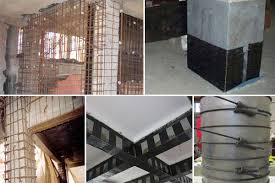Assessment of a strengthened concrete bridge girder Semester 2020
Individual Project
Weighting: LTC assessment
An existing box girder bridge shown in figures 1 and 2 is simply supported, spans 30m and has recently been strengthened with CFRP over 10 years ago. As the new consulting engineer on the project, you are required
to determine the maximum load rating of the bridge girder, accounting for all possible failure modes. A site investigation has confirmed the following properties: fc’ = 35 MPa, Es=200,000 MPa, fst=500 MPa and cover to ligatures is 25mm. Note bottom flange thickness is 150 mm.
CVE80005 Strengthening & Monitoring of Structures LTC Assessment-Swinburne University Australia.



Figure 2 – Cross section of 1 span bridge
The bridge can be assumed to be supporting a uniformly distributed load (UDL) along its span. As part of the assessment exercise, you are required to determine the following:
1.The maximum ultimate UDL load at which the girder will fail in flexure.
- You must consider two cases: with and without considering the top compression steel reinforcement in your analysis.
- Include all debonding and anchorage checks in your assessment: IC debonding, end interfacial delamination, concrete cover separation failure and end anchorage checks.
- After the sectional capacities are attained for the various failure modes, the maximum ultimate load the girder can support should be calculated in kN/m.
2.The maximum ultimate UDL load at which the girder will fail in shear.
- You must determine the shear capacity of the member in the strengthened zone at the critical section away from the support.
- After the sectional capacity in shear is attained, the maximum ultimate load the girder can support should be calculated in kN/m.
3.The maximum serviceability UDL load at which the serviceability requirements will still be met.
- You must consider both top and bottom reinforcement in your analysis.
- Determine the flexural load to fail the serviceability requirements of the beam in the mid-span.
- Include all FRP in your calculations and check stress violation conditions of FRP creep rupture, steel serviceability stresses and concrete stress limits at service.
The following FRP properties should be used in design:
CVE80005 Strengthening & Monitoring of Structures LTC Assessment-Swinburne University Australia.



